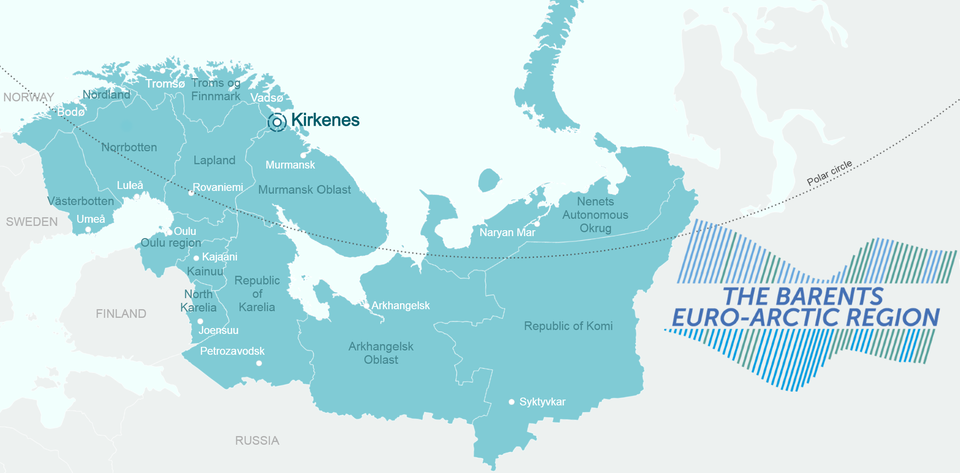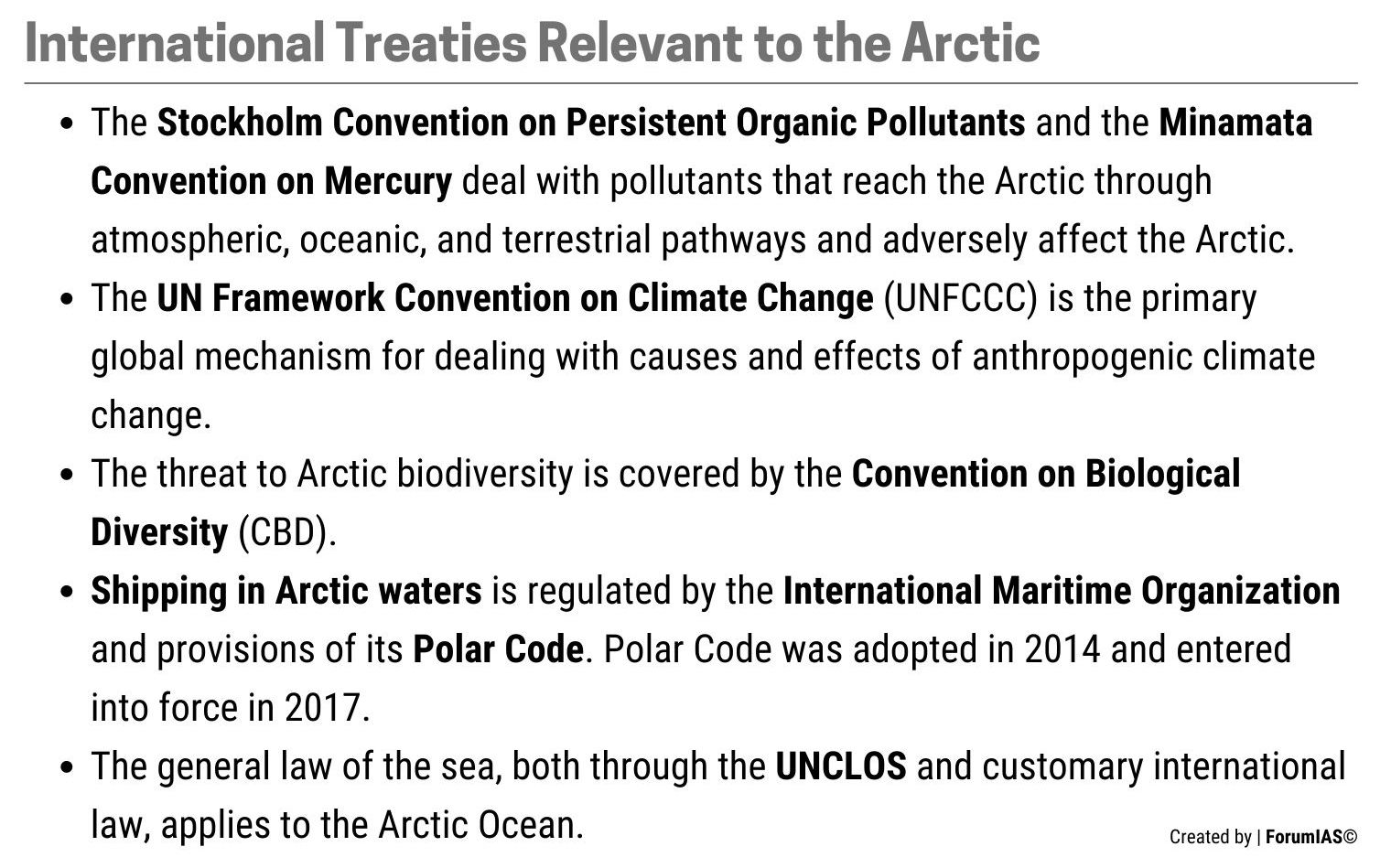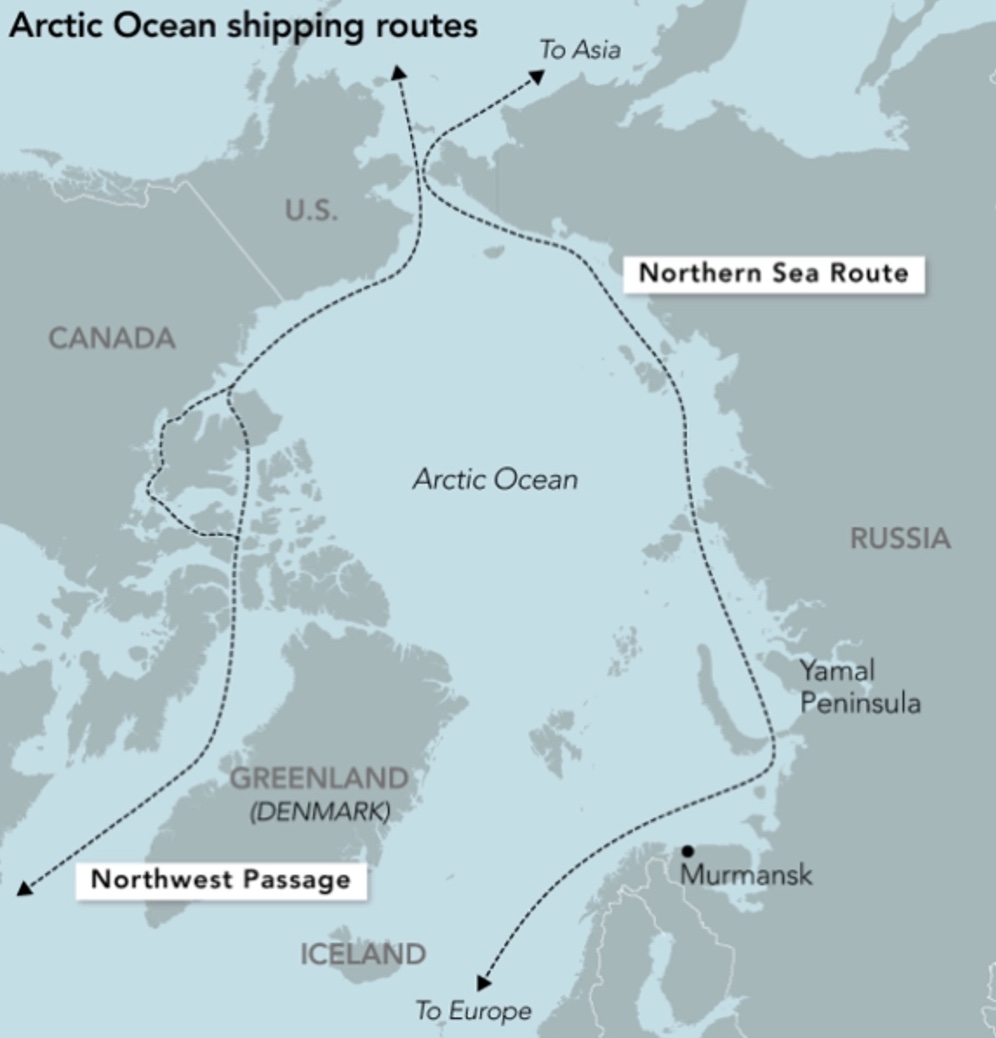ForumIAS announcing GS Foundation Program for UPSC CSE 2025-26 from 19 April. Click Here for more information.
Contents
| For 7PM Editorial Archives click HERE → |
Introduction
The launch and flag raising ceremony of two nuclear-powered icebreakers was held in St. Petersburg, Russia recently. At the ceremony, the Russian President said that the icebreakers were of strategic importance and would help strengthen Russia’s status as a “Great Arctic Power”. The melting of the Arctic Ice has increased global attention on potential commercial opportunities, research, and peace and stability in the region. The lack of proper framework for governance of Arctic has raised concerns that the gap may open a confrontational theatre. Moreover, unchecked exploitation of the resources of Arctic and the resulting consequences may have a runaway effect on global climate. This raises the need for an international cooperative framework for the governance of the Arctic.
What is the importance of Arctic Region for the World and India?
Environment, Climate Change and Scientific Research
Arctic is crucial for Global climate. Arctic ice acts as a big reflector of sunlight and help maintain radiation balance and moderating the temperature. Any change in the Arctic will have deep implications for the global climate. From 1971 till 2019, the Arctic snow cover and the extent of Arctic sea ice have shrunk by 21% and 43% respectively, and all regions of the Arctic experienced net loss of land ice. It will result in global sea-level rise, which is already getting evident.
Scientists believe that Arctic ice cover has an impact on monsoon rainfall as well, although the relationship has not been established with full certainty.
The Arctic and the Himalayas, though geographically distant, are interconnected and share similar concerns. The Arctic meltdown is helping the scientific community to better understand the glacial melt in the Himalayas. Himalayas have often been referred to as the ‘third pole’ and have the largest freshwater reserves after the North and South poles. They are also the source of main rivers of India, including the Ganga and Brahmaputra, the basins of which support a population of about 600 million and 177 million respectively and generate over 40% of India’s GDP. The study of Arctic is therefore critical to Indian scientists.
Source: US Department of State
Economic and Human Resources
Mineral Resources and Hydrocarbons: Arctic region has rich deposits of coal, gypsum and diamonds and also substantial reserves of zinc, lead, placer gold and quartz. Greenland possesses about a quarter of world’s rare earth reserves. A US Geological Survey (USGS) appraisal of the Arctic estimated that the region “may constitute the geographically largest unexplored prospective area for petroleum remaining on Earth” amounting to 30% of the world’s undiscovered natural gas and 13% of the world’s undiscovered oil. With the increasing ice-melt, these resources are becoming more accessible and feasible for extraction. The resources have implications for India’s energy security as well.
Geopolitical and Strategic
The opening of the shipping routes and possibilities of increased resource extraction has led to scramble for establishing position of influence among Russia, China, the US (and the NATO) among others. In 2018, Russia and NATO conducted Exercise Vostok and Trident Juncture respectively, their largest since the Cold War.
Apart from the strategic contestation, there are unresolved boundaries between the Arctic States e.g., the US has continental shelf overlap with Canada and Russia, while Russia and Canada themselves have differing continental shelf claims.
What is the current framework for Governance of the Arctic?
Unlike Antarctica, that has the Antarctic Treaty System, there is a lack of comprehensive overarching framework for the governance of the Arctic. There is no single governing body for the Arctic. However, there are several organizations that loosely cooperate.
The most successful has been the Arctic Council, a forum of the 8 Arctic nations; Canada, Denmark, Finland, Iceland, Norway, Sweden, the Russian Federation, and the US. It was established by the Ottawa Declaration in 1996, and is the preeminent intergovernmental forum for addressing issues related to the Arctic Region. The Arctic Council is not a treaty-based international organization but rather an international forum that operates on the basis of consensus. It has recently signed three legally-binding agreements among Arctic States. The Arctic Council primarily deals with environmental protection and sustainable development.
Source: WWF
Other institutions and organizations associated with the Arctic include:
Barents Euro-Arctic Council (BEAC): It is a forum for intergovernmental cooperation on issues concerning the Barents Region and its sustainable development. The members of BEAC are Denmark, Finland, Iceland, Norway, Russia, Sweden and the European Commission, with Germany and 8 other countries as Observers.
Nordic Council (NC): It is the official body for formal inter-parliamentary cooperation among the Nordic countries as well as the autonomous areas of the Faroe Islands, Greenland, and the Åland islands.
Northern Forum (NF): It is an international organization composed of sub-national or regional governments from nine northern countries. The NF is a regional voice on the current Arctic agenda and an Observer to the Arctic Council.
Northern Dimensions (ND): It is the joint policy of 4 partners: the European Union (EU), Russian Federation, Norway and Iceland, with EU member states also participating in their national capacities. The ND aims at supporting stability, well-being and sustainable development in the region and focuses on environment, transport and logistics.
Standing Committee of Parliamentarians of the Arctic Region (SCPAR): Standing body of the biennial Conference of Parliamentarians of the Arctic Region represents the 8 Arctic countries and the European Parliament.
What are the challenges in Governance of the Arctic?
Not a Global Common: Arctic does not conceptually qualify as a global commons (much of the region’s ocean falls within the recognized national jurisdictions of the Arctic coastal states). There are complex sovereignty issues, as the region encompasses areas and resources within and outside national jurisdictions. Therefore, it is very difficult to formulate a unified Arctic treaty system, similar to the one that exists for the Antarctica.
Militarization: The North Atlantic Treaty Organisation (NATO) has been conducting regular exercises in the region while partner countries are investing in upgrading military capabilities. There has been a rapid increase in military outposts along Russia’s northern coast.
Emergence of Northern Sea Route: Northern Sea Route is emerging as a new strategic international energy corridor. Russia has demanded for restrictive measures along the shipping route, including that all foreign warships provide advance notice and get Russian approval prior to transit. Such measures limit international access to this sea lane and challenge freedom-of-navigation rules defined by the UN Convention on the Law of the Sea.
At the same time, China, which calls itself to be a near-Arctic State, has also announced ambitious plans for a ‘Polar Silk Route’ to connect to Europe as well building massive icebreakers.
Exclusive Economic Zone (EEZ) Dispute: The global warming and predicted melting of Arctic sea ice has stimulated the discourse on extended EEZ towards the north pole in a hope of possible natural resource discoveries.
Fragmentation of Governance Mechanisms: The existence of multiple organizations makes it difficult to coordinate responses to and effectively manage national, subregional, regional, and global Arctic challenges e.g., even though UNCLOS applies to the Arctic, it does not contain provisions that determine the policies and procedures regarding Arctic scientific research and resource extraction.
What has been the India’s approach towards the Arctic?
Arctic Policy: India unveiled its Arctic Policy (‘India and the Arctic: Building a Partnership for Sustainable Development’) in March 2022. The Policy has laid down 6 Pillars: (a) Strengthening India’s scientific research and cooperation; (b) Climate and environmental protection; (c) Economic and human development; (d) Transportation and connectivity; (e) Governance and International Cooperation; (f) National capacity building in the Arctic Region. The Arctic Policy has been synchronised and adapted to Goal 11 of Sustainable Development Goals.
Global Presence: (a) India is also one of the 13 Observers in the Arctic Council; (b) India got elected to Council of the International Arctic Science Committee (IASC) in 2012, followed by its induction to the Council with observer status in 2013; (c) India is also signatory to the Svalbard Treaty that recognises the sovereignty of Norway over the Arctic archipelago of Svalbard.
Scientific Research: India has taken several initiatives for scientific research in the Arctic: (a) India launched its first scientific expedition to the Arctic in 2007 and set up a research station ‘Himadri’(2008) in the international Arctic research base at Ny-Ålesund in Spitsbergen, Svalbard, Norway; (b) In 2014, India deployed IndArc which is a multi-sensory observatory in Kongsfjorden, Svalbard, Norway; (c) In 2016, India set up Gruvebadet Atmospheric Laboratory at Ny Alesund, Svalbard, Norway; (d) Indian researchers are monitoring arctic glaciers for their mass balance and comparing them with glaciers in the Himalayan region; (e) India has also been actively involved in studies related to the Arctic oceanography, atmosphere, pollution and micro-biology; (f) Over 25 Institutes and Universities are currently involved in Arctic research in India. The National Centre for Polar and Ocean Research (NCPOR) in Goa (under the Ministry of Earth Sciences), is the nodal institution for India’s Polar research programme; (g) India has successfully conducted thirteen expeditions to the Arctic so far.
What should be done going ahead?
First, There is a need for a consensus-based decision-making process. There is need to strengthen the existing multi-tier Arctic governance structure by considering the issue at global level, at regional level, and at the sub regional level. Sustainability should be the guiding principle for cooperation, while balancing protection and resource utilization.
Second, there is a need to establish a comprehensive framework governing all aspects of the Arctic region. However, a US-based think tank recommends that rather than negotiating an all encompassing treaty in one-go, the existing institutional arrangements can be broadened to gradually cover all relevant issues. This approach better conforms to current geopolitical realities in the Arctic and, to some extent, would avoid the potential race for dominance among existing governance mechanisms.
Third, Governance of the Arctic should be based on respect for the sovereign rights and jurisdictions of Arctic countries while taking into account the concerns of non-Arctic states and non-state actors in accordance with relevant international treaties and international law.
Fourth, All relevant parties should be encouraged to contribute capital, technology, and human resources toward fostering new models of cooperation in setting the agenda and building institutions for Arctic governance.
Fifth, Scientific research should be prioritized. Interested parties should promote joint research and data sharing. Besides conducting research on climate change trends and ecological assessments, innovation in both the natural and social sciences can be promoted by strengthening research on Arctic politics, economics, law, society, history, culture, and the management of human activities.
Conclusion
The rapid effects of climate change as well as technological innovation intensify the need for increased interaction and coordination among existing frameworks affecting the Arctic. The developments in the Arctic will have direct and indirect impacts on India’s strategic interests. As India is poised to play a greater role in global geopolitics, India should push for a consensus based approach guided by principles of sustainability to formulate a comprehensive framework for the governance of the Arctic.
Syllabus: GS II, Bilateral, regional and global groupings and agreements involving India and/or affecting India’s interests; Effect of policies and politics of developed and developing countries on India’s interests; Important International institutions, agencies and fora.
Source: The Hindu, NewsOnAir, PIB, German Arctic Office, Council on Foreign Relations, IDSA









